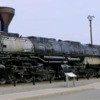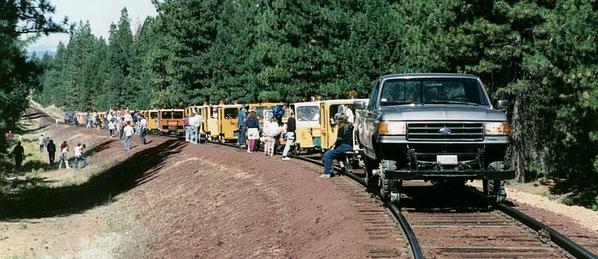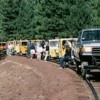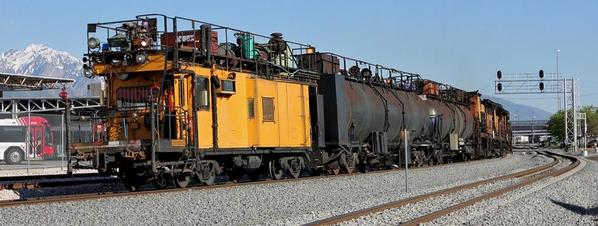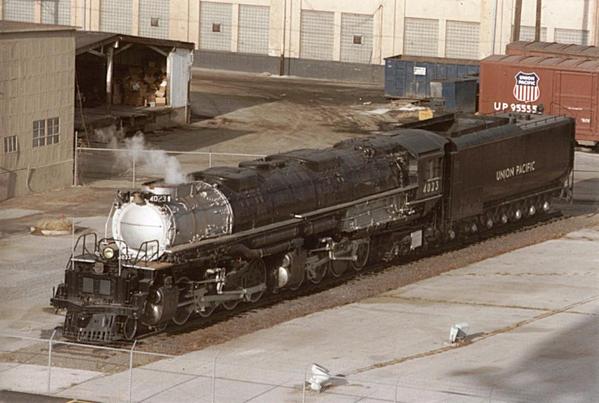Does anyone know if there were any caveat's placed on the equipment the railroad gave to the museums? When the military gives a tank, ship or plane to someone to display the government retains ownership and can retrieve the asset anytime.
Does anyone know if there were any caveat's placed on the equipment the railroad gave to the museums? When the military gives a tank, ship or plane to someone to display the government retains ownership and can retrieve the asset anytime.
I'm pretty sure that park or museum locomotives are no longer on the railroad's books (otherwise, it probably would be a taxable asset) and were donated or sold with the intention of them never returning to the railroad.
Rusty
Does anyone know if there were any caveat's placed on the equipment the railroad gave to the museums? When the military gives a tank, ship or plane to someone to display the government retains ownership and can retrieve the asset anytime.
I would highly doubt it as well.
Why would a potentially restored Big Boy "have to" be converted to burn oil? NKP 765 still burns coal. And we don't have to import coal.
Why would a potentially restored Big Boy "have to" be converted to burn oil? NKP 765 still burns coal. And we don't have to import coal.
1) The UP 4000 class locomotives, as well as the Challengers, where all designed to burn Wyoming "Hana" coal, and they went through HUGE quantities of it, which produced HUGE quantities of red hot cinders.
2) The U.S. Forestry Service "restricted" 3985 to ONLY the state of Wyoming, i.e. Sherman Hill, when she was still a coal burner. Why, because she set fire to everything, every place she went! Thus, 3985 was converted to oil burning in 1989/1990, in order to run west to California for the tenth anniversary of the California State Railroad Museum.
Hot Water, you reminded me of a question I've had for a long time. When the UP had many steam engines and they were burning coal what was done to prevent fires back then?
On the publicity thing - either you swear participants to secrecy, or you expect leaks. If publicity is enough to sour this deal, then maybe they were not serious to start with.
If the bucks are allocated, then this thing will go forward no matter what we post. If the money is not there, then they are just generating publicity, and it will have little effect on anything.
Obviously, opinion. Rich's opinion is far more informed than mine.
Why would a potentially restored Big Boy "have to" be converted to burn oil? NKP 765 still burns coal. And we don't have to import coal.
When the Challenger came to Utah in late 80's early 90's they had to have a cinder crew to follow behind it to douse fires. I remember a headline in the paper along the lines of "Fire Officials Glad to See Train leave state" when it departed. It was discouraged from coming back until it got oil
I think back in he old days they fires were still a problem however many more areas along the tracks were less populated so the fire burnt out without notice. And just like in the what should be happening in the forests today, a lot of little fires prevented big fires from happening.
And don't forget you had this guy roaming the rails in search of fires to put out
Fires are not entirely gone, just about 5 years ago there was a fire at the mouth of Weber Canyon here in Utah caused by sparks from a train wheel, I am sure there are others
Why would a potentially restored Big Boy "have to" be converted to burn oil? NKP 765 still burns coal. And we don't have to import coal.
1) The UP 4000 class locomotives, as well as the Challengers, where all designed to burn Wyoming "Hana" coal, and they went through HUGE quantities of it, which produced HUGE quantities of red hot cinders.
2) The U.S. Forestry Service "restricted" 3985 to ONLY the state of Wyoming, i.e. Sherman Hill, when she was still a coal burner. Why, because she set fire to everything, every place she went! Thus, 3985 was converted to oil burning in 1989/1990, in order to run west to California for the tenth anniversary of the California State Railroad Museum.
I'm sure there must be some good American technology that can solve the problem of coal-burning steam locomotives emitting excessive quantities of sparks. Add a big headlight for safety and historic heritage, too.
Might have to use the Santa Fe trick to fold it down for tunnels.
Attachments
Why would a potentially restored Big Boy "have to" be converted to burn oil? NKP 765 still burns coal. And we don't have to import coal.
I would think another good reason would be the fueling itself, it is much easier to have a tanker pull up to where you are. Plus no fire to clean, ashes to dump ect...I know Rich has stated many times that he would love to convert the 765 to oil. Heck I won't care if it burns crayons just so long as one comes back to life. ![]()
Ace that is just wrong...LOL![]() poor Otto Jabelmann is rolling over in his grave.
poor Otto Jabelmann is rolling over in his grave.
I'm going to chime in here on the coal burning issue. When the 3985 made its last trip burning coal, they had some terrible stuff that was too large and had too much rock. The auger kept jamming. They cleared it several times by reversing the motor or digging it out, but eventually it jammed so bad they couldn't get it going again, and had to hand fire the thing. Bob Kreiger lost about 20 pounds that day shoveling. Some thought had already gone into converting it to oil, but that day made the decision for them.
About fires on the right of way-
There were lots of fires when coal burning steam was the only thing. So much so, that in the short growing season here in Wyoming, kept the brush and grass along the right of way down and prevented bigger fires. The railroad also had fire crews and a water service, as well.
Anything is possible, but probable is not likely. ![]()
I think a coal-burning Big Boy could find a lot of volunteers to follow behind as a fire safety crew.
True, but now instead of a 50mph steam engine holding up traffic, you are now dealing with a 50mph steam engine AND a 20-25mph group of NARCOA members behind it. Talk about fouling up a mainline.
You're better off just figuring out the logistics of making an oil-firing system work.
Kevin
Hot Water, you reminded me of a question I've had for a long time. When the UP had many steam engines and they were burning coal what was done to prevent fires back then?
Back in the day, NOTHING grew need the right of way! The constant rain of hot cinders kept all vegetation burt off the right of way. In fact, to this day one can walk a bit away from the ballast line on many of the long grades on the double track UP main line, and the cinders are STILL there, just below the top growth of prairie grasses.
Just wanted to share the last bit of video with you guys.
Quick Question for Hotwater.
Where on the U.P. mainline did the smoke stake covers come in handy on the big boys?
28 tons of coal in half a 58 mile trip??? Thats about a mile to the ton... ![]() Tickets would have to be $500 to pay for just the coal...
Tickets would have to be $500 to pay for just the coal...
28 tons of coal in half a 58 mile trip??? Thats about a mile to the ton... ![]() Tickets would have to be $500 to pay for just the coal...
Tickets would have to be $500 to pay for just the coal...
You're mileage may vary...![]()
Rusty
Quick Question for Hotwater.
Where on the U.P. mainline did the smoke stake covers come in handy on the big boys?
Primarily for use in tunnels. The Challengers had them also.
Didn't they also have a spray nozzle mounted on top of the rear of the tender to wet down the old wooden stock car roofs so they wouldn't catch on fire from the hot cinders?
Chuck,
Yes they did. Photos of them at work should be in the book "Big Boy".
ChipR
Yeah they had a 3/4 inch line that could spray back quite a ways. Pretty good idea.
I like how the narrator in the part#2 of the video called the Engineer's seat " The Hero Throne "
Is that what I sat in today ? ![]()
I like how the narrator in the part#2 of the video called the Engineer's seat " The Hero Throne "
Is that what I sat in today ? ![]()
Yes...yes you did.....![]()
Firefighting caboose and water cars to bring up the end of a coal-burning BigBoy train:
Right! Keep dreaming.
With all that black smoke there must have been some foamers around ![]()
Firefighting caboose and water cars to bring up the end of a coal-burning BigBoy train:
Right! Keep dreaming.
Better to brainstorm in good humor than to be cynical and critical.
Guess I missed the humor in the photographs of the rail grinding train.
If the project goes forward, there is no way UP will leave her in coal. It would be the early days of the 3985 all over again. But on a side note those rail grinders are something else to watch, really an impressive machine(s).
I would think the crew near I-80 and I-25 have enough to worry about than having to fire up a Big Boy.
I would think the crew near I-80 and I-25 have enough to worry about than having to fire up a Big Boy.
Why?
I seriously doubt that any person in or near the steam program would not be delighted with another locomotive to care for and fire. There are plenty of other things they could do with their time if they are not interested in restored steam.
Opinion.
I would think the crew near I-80 and I-25 have enough to worry about than having to fire up a Big Boy.
Why?
844, 3985, 6936, E-Units, passenger cars, snowplow.....
I Google earthed I-25 and I-80. The intersection is outside Cheyenne Wyoming. Just to the left is a large Union Pacific Yard and a roundhouse. Maybe this is where the Big Boy would be stored.
Union Pacific Railroad Cheyenne, Wyoming Roundhouse. Base of operations for historical UP steam and diesel locomotives 4-8-4 #844, 4-6-6-4 #3985 (currently the world's largest operating steam locomotive), E9s #949, 951 & 963B , DDA40X #6936 (world largest diesel locomotive) and support equipment. Union Pacific has the only corporate heritage operation of any major railroad. Built in 1932, the roundhouse used to have total of 48 stalls, now only 7 stalls of the old passenger house remain.
Now we know.
I Google earthed I-25 and I-80. The intersection is outside Cheyenne Wyoming. Just to the left is a large Union Pacific Yard and a roundhouse. Maybe this is where the Big Boy would be stored.
The "long stalls" for the 4000 class locomotives are no longer part of what is left of the roundhouse in Cheyenne.





